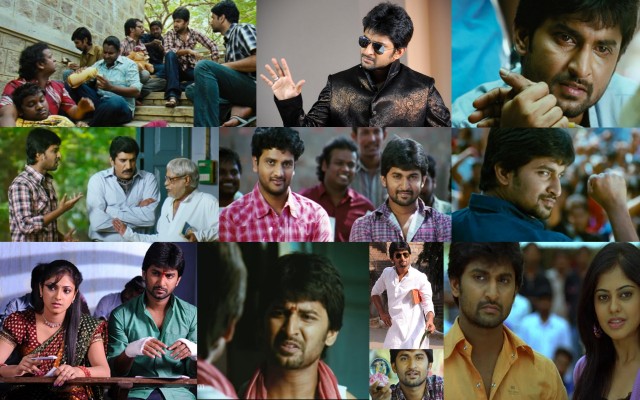
Declared a one-time watch when it first released, Pilla Zamindar is probably one of the most watched films in the Telugu industry in recent times. While some films are made to be instant classics, others grow on you with time. They are the type of films that freeze your fingers when they flash on the television while channel surfing, and before you know it, you are watching it for the hundredth time. These films may not come to mind, when asked to name your favorite movie, but end up being one of your most watched films. There are very few films that have that power, and Pilla Zamindar is one of them.
There are many reasons why I love Pilla Zamindar, the top one being Nani and his portrayal of PJ. PJ’s transformation from a rich spoilt brat to the good boy on campus is a treat to watch. Nani’s effortless performance is what makes PJ so endearing. Equally impressive is the support cast in the form of Rao Ramesh, M.S.Narayana, Srinivas Avasarala, Randhir and Hari Priya. Rao Ramesh as the stern but caring Principal and M.S.Narayana as the aging Telugu teacher steal the show in some scenes. While there are many movies based on college life, what makes Pilla Zamindar special is the valuable lessons it teaches us. The movie is best summed up by a dialogue that PJ delivers towards the end of the film”Naku patallu nerpindhi meere kadhu sir, inko iddaru vunnaru, Jeevitham, Kalam. Ikkada nenu gadipina jeevitham motham kalam villuvu choopisthe, ikkada gadipina rendu ela kallam jeevitham emito chupinchindhi” (Sir, you are not the only ones who taught me lessons, there are two more things, Life and Time. If my life here taught me the value of time, it is my two years here that taught me the value of life).
And what lessons they were! In the process of transforming PJ the film ends up teaching us a lot of life lessons too. Of the many lessons that PJ learns, the ones that stand out are Rajanna’s wise words to PJ when he is scared that he might loose – “Gelupu emi vundhi ra, maha aithe prapanchaniki ninnu parichayam chesthundi, oka sari odipoyi choodu, prapancham ante emito neeku parichayam avthundi” (What’s there in winning, at the most it will introduce you to the world. Loose once and see, and you will be introduced to the real world). Equally thought provoking are Kannababu’s words when PJ does not understand how the poorest of the poor can still be so happy – “Devudu manushulu ni premichadaniki, vosthulu ni vadukodaniki shrustincharu. Gani maname confusion tho manushulu vadukuni, vosthulni premisthunamu. Adhi marina roju antha anandame, antha trupte“(God created people to love and things to use, but in our confusion we are using people and loving things. The day that changes there will be no limit for happiness and satisfaction in this world). But the one that made the biggest impression on me were the words that Udhandam says in reply to PJ’s comment of the Telugu language dying -“Debba tagilthe “shit” ane ashudhani notilo vesukune meeku Telugu gopathanam emi ardham avthundi” (How would you understand the greatness of Telugu (your mother tongue) when you use filthy words like “shit” (instead of amma) when you are hurt).
While almost every character has some wise words to impart, it is the character of Udhandam that made the biggest impression on me. For the first time I was ashamed that I did not know how to read and write my own mother tongue (Telugu). When we were young, my parents made us choose Hindi as our second language, with the hope that they would teach us Telugu. Sadly they never found the time, and we never tried to learn the language either. While I was always a little guilty for never learning my own mother tongue, the guilt hit me very hard after watching this film. This is a film that every Telugu speaking person must watch, and if possible the movie should be remade in other languages too, to awaken the lost pride of many of our beautiful languages. It breaks my heart when I think of how careless we are with our languages, that probably took our forefathers a very long time to develop.
While all this sounds a little heavy and deep, Pilla Zamindar is not all about sentiment. In fact, it is the comedy that makes people go back to it again and again. Who can forget the punishment scenes of PJ while Ayyayyo plays in the background, or when Udhandam slaps him for mispronouncing a word in Telugu. Irrespective of what the critics said about the film, Pilla Zamindar is like potato chips, you can never stop after one (watch).




